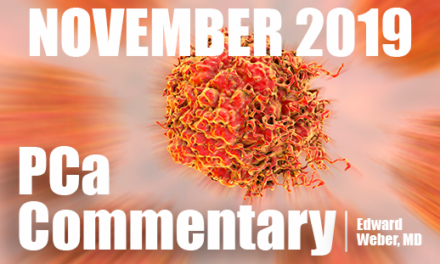
PCa Commentary | Volume 130 – January 2019
Posted by Edward Weber | January 2019
Ga68-PSMA-11 PET/CT Scanning at Initial Diagnosis for High-Risk Prostate Cancer: What is missed by conventional staging and does it matter?
This Commentary benefited from a review and suggestions from Thomas Hope, MD, Associate Professor of Abdominal Imaging and Nuclear Medicine, UCSF
THE FIRST QUESTION likely is why present a Commentary about the Gallium68-PSMA-11 PET/CT scan? Its availability is very limited in the US and, additionally, it is currently not FDA approved and only available via protocol.
ANSWER: Extensive research for its application in staging high-risk prostate cancer patients at initial diagnosis in Europe and Australia and more recently at UCSF and UCLA has shown its utility in affecting management decisions. It is reasonable to predict that, in time, the weight of additional research into its role for initial staging in high-risk patients will lead to approval for this purpose.
So… what has been learned so far about this application?
Executive Summary:
For this Commentary, eleven research papers reporting the results for the Ga68-PSMA PET/CT applied to high-risk prostate cancer were reviewed. For interest, here is the list of research locations: Australia (3, where the scan is readily available), India, Turkey, Germany (2), Jordan, and the USA (3, UCSF, UCLA, and Johns Hopkins).
A summary is straightforward since all the articles uniformly reported similar findings:
- The PSMA scan consistently outperformed staging accuracy for CT, MRI (abdomen and pelvis), and 99mTc bone scintigraphy.
- Although all of the studies focused on men with at least locally advanced disease at diagnosis (>cT3 and b) and Gleason score > 4+3, the mix of patient characteristics in the various studies prevented a matched overall tabulation. But a Gestalt clearly emerged, allowing an approximation of the locations of PSMA-positive lesions:
- Pelvic lymph nodes ~25%.
- Lymph nodes outside of the pelvis ~13%.
- Metastases to bone ~21%.
- The intended pre-scan management treatment plan was changed in 20 – 50% of instances based on the scan findings due mainly to upgrading, but occasionally resulting from down-staging.
Details of One Study As An Example:
Calais, et al. “Potential Impact of 68Ga-PSMA-11 PET/CT on the Planning of Definitive Radiation Therapy for Prostate Cancer.” , UCLA, Essen, Germany.
VA Greater Los Angeles Healthcare System. J Nucl Med, November 2018. The initial sentence sets the tone: ”Standard-of-care imaging for initial staging of prostate cancer (PCa) underestimates disease burden.”
- Patient characteristics: Of 73 patients, 15% were intermediate-risk; 45%, high-risk; and 30% were very high-risk. The median PSA was 13.9 (range 0.22 – 909 ng/mL).
The Gleason score was 7 in 37% and >8 in 60%.
- PSMA scan-positive findings: Pelvic lymph nodes, 34%; distant metastases, 9.5% (e.g., LNs beyond the pelvis, 5.5%; metastases to bone, 5.5%; and one lesion in lung).
“The median size of LN lesions was 6 mm (range 2 – 24).”
Two points of importance:
- Only 6 of the 25 pelvic nodes identified on the PSMA scan were seen on the CT portion of the scan.
- Of the seven patients with distant metastatic disease, four were oligometastatic, “suggesting a possible role for metastases-directed therapy in most of the M1 [metastatic] patients in this cohort.”
Take-away from the study:
A standard prostatectomy including a pelvic lymph node dissection or conventional radiation including the pelvic nodes would have left nearly 10% of the disease burden untreated. If radiation had not been planned to include pelvic lymphs, these nodes would have received no definitive treatment. The challenge for surgeons and radiotherapists is how to encompass this not insignificant percentage of patients into their therapy plans.
A Natural Question: Which is the superior PET/CT — the Axumin or the Gallium68-PSMA-11 scan?
Many comparative studies establish these two PET/CTs as the leaders of the field for assessing men with recurrent disease after primary therapy. While the material cited above indicates abundant research into PSMA PET/CT for initial staging, there are no published studies for the Axumin PET/CT in staging men at the time of initial diagnosis. However, research for the Axumin scan in high-risk patients likely will be forthcoming. Considering their potential impact on management decisions, having either or both scans available for initial staging would be a valuable addition.
One Small Comparative Study: A small retrospective study compared the two scans in a case series of 10 patients imaged in short sequence at recurrence. “Five of 10 patients (50%) were negative with 18F-fluciclovine [Axumin] but positive with 68Ga-PSMA-11 PET/CT.” The PSMA scan detected a greater number of lymph nodes. The report, however, came with a caveat that the study was “far from definitive evidence for superiority” (Calais, et al., J Nucl Medicine, May 2018).
A recently completed randomized trial (NCT03515577) sponsored by UCLA compared the performance of the PSMA v. Axumin scans in detecting the sites of recurrence. It aimed to study 49 patients. The results should be publicly available soon.
Availability of the Two Scans: The Medicare reimbursed and FDA approved Axumin scan is available at over 400 locations (and its availability is likely increasing steadily). The PSMA scan has only limited availability and is always done under protocol — UCSF, UCLA, Stanford, Michigan, the Mayo Clinic, Sloan Kettering, and Cornell Medical. Additionally, the Ga68-PSMA-11 scan may not currently be the optimal formulation for PSMA imaging. Research is ongoing regarding more efficient isotopes and linkers, such as 18F-PSMA-1007, 68Ga-PSMA-I&T, and 18F-DCFPyL.
BOTTOM LINE:
Accurate staging is essential for optimal management decisions. Current imaging with computerized tomography, magnetic resonance imaging, and 99Tc bone scanning lack the sensitivity to provide the needed information for accurate staging of high-risk patients at initial diagnosis. Early studies with the 68Gallium-PSMA-11 PET/CT in this population have reported significantly improved detection rates compared to current technology.
Your comments and requests for information on a specific topic are welcome e-mail ecweber@nwlink.com. Please also visit https://prostatecancerfree.org/prostate-cancer-news for a selection of past issues of the PCa Commentary covering a variety of topics.
“I want to thank Dawn Scott, Staffperson, Tumor Institute Radiation Oncology Group, & Mike Scully, Librarian, Swedish Medical Center for their unfailing, timely, and resourceful support of the Commentary project. Without their help this Commentary would not be possible.”
ABOUT THE AUTHOR
Edward Weber, MD, is a retired medical oncologist living in Seattle, Washington. He was born and raised in a suburb of Reading, Pennsylvania. After graduating from Princeton University in 1956 with a BA in History, Dr. Weber attended medical school at the University of Pennsylvania. His internship training took place at the University of Vermont in Burlington.
A tour of service as a Naval Flight Surgeon positioned him on Whidbey Island, Washington, and this introduction to the Pacific Northwest ultimately proved irresistible. Following naval service, he received postgraduate training in internal medicine in Philadelphia at the Pennsylvania Hospital and then pursued a fellowship in hematology and oncology at the University of Washington.
His career in medical oncology was at the Tumor Institute of the Swedish Hospital in Seattle where his practice focused largely on the treatment of patients experiencing lung, breast, colon, and genitourinary cancer and malignant lymphoma.
Toward the end of his career, he developed a particular concentration on the treatment of prostate cancer. Since retirement in 2002, he has authored the PCa Commentary, published by the Prostate Cancer Treatment Research Foundation, an analysis of new developments in the prostate cancer field with essays discussing and evaluating treatment management options in this disease. He is a regular speaker at various prostate cancer support groups around Seattle.





